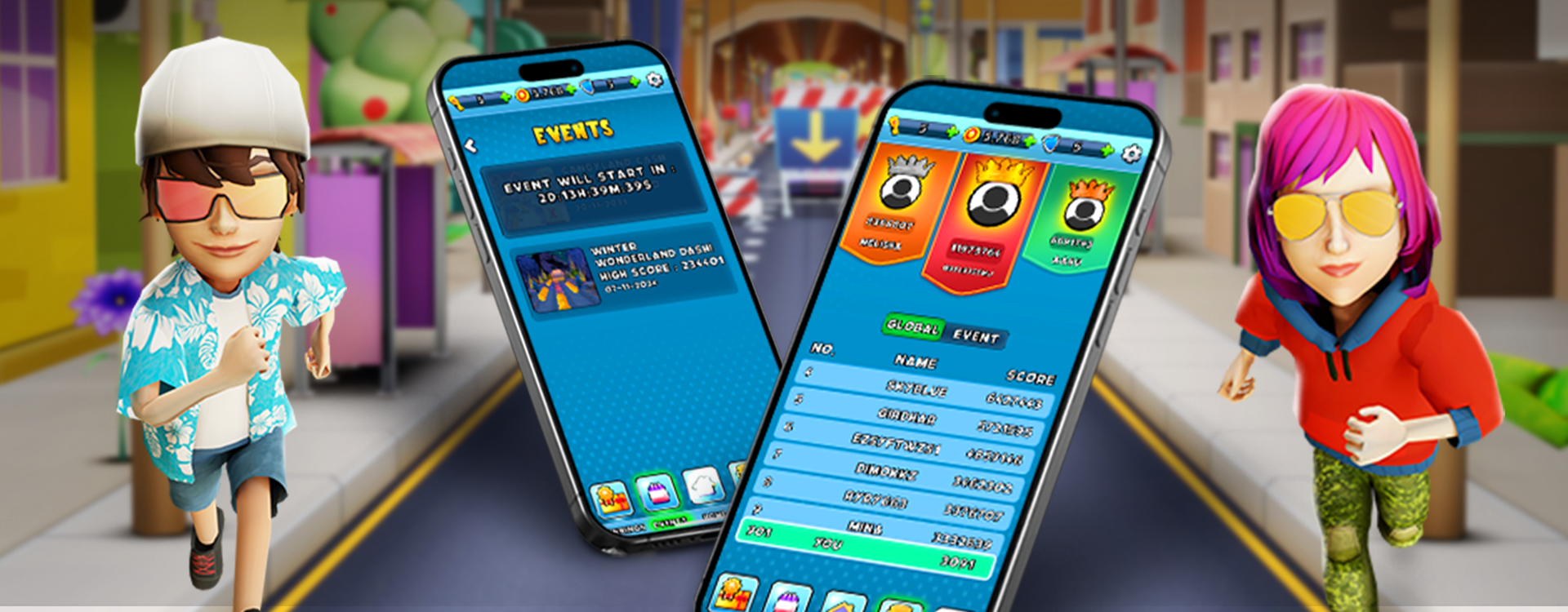In the fast-paced world of mobile gaming, creating an engaging community is crucial to a game’s success. Runner Runner, a popular endless running game, has excelled in leveraging features like leaderboards and challenges to boost player engagement and foster a sense of community. These competitive elements not only encourage players to improve their skills but also contribute to a thriving online community where players connect, share strategies, and celebrate each other’s achievements.
This blog post dives into how leaderboards and challenges can build community, drive competition, and sustain engagement in games like Runner Runner.
1. The Value of Community Engagement in Gaming
Community engagement is more than just a collection of active players. It represents the sense of belonging, competitiveness, and interaction among players that enrich the gaming experience. When players feel connected to others within a game, they are more likely to return, compete, and engage deeply. Community-centered games also benefit from player-driven content—social media posts, videos, guides—that boost visibility and attract new players.
In Runner Runner, community engagement is woven into the fabric of the game, encouraging players to interact with each other and stay motivated. Features like leaderboards and challenges are pivotal tools that enable this engagement by creating spaces where players can measure their progress against others, strive to achieve goals, and celebrate milestones.
2. How Leaderboards Drive Competitiveness and Retention
Leaderboards are essential in competitive gaming, providing players with a clear, quantifiable measure of their progress and skill level. By placing players’ scores or achievements in a ranked list, leaderboards motivate them to climb higher and outperform others. This sense of progress and accomplishment can turn casual players into dedicated fans who return daily to improve their rank.
a. Weekly and Daily Leaderboards
Runner Runner uses both weekly and daily leaderboards to encourage regular play. The shorter cycle of these leaderboards prevents top players from dominating the rankings indefinitely and gives all players a fresh opportunity to rise to the top each week or day. This renewal of rankings incentivizes players to return frequently and work on improving their performance, creating an active player base.
b. Global vs. Friend-Specific Leaderboards
Another layer of motivation comes from the option to compete globally or within a smaller friend group. While a global leaderboard showcases top-tier players from around the world, a friend-specific leaderboard allows players to compete with people they know, adding a personal touch to the competition. This can encourage friendly rivalry and camaraderie as friends push each other to achieve higher scores.
c. Rewards and Recognition
Leaderboards in Runner Runner also offer rewards for top performers, such as exclusive avatars, badges, or in-game currency. These rewards not only motivate players to strive for high rankings but also serve as a form of recognition within the community, marking the player’s achievement. Exclusive rewards give players a reason to pursue leaderboard rankings and create pride in their performance, boosting long-term retention.
3. Challenges as a Tool for Fostering Engagement and Community-Building
Challenges are another effective way to keep players engaged and connected. In Runner Runner, challenges are often themed, time-limited tasks that encourage players to complete certain actions or achieve specific milestones. These challenges add variety to the gameplay and provide an alternative goal for players beyond the leaderboard ranking.
a. Daily, Weekly, and Special Event Challenges
Runner Runner offers challenges in different frequencies—daily, weekly, and for special events. Each type of challenge appeals to different player motivations. Daily challenges are straightforward, easy-to-complete tasks that provide small rewards, ideal for casual players. Weekly challenges are more complex, requiring greater skill or dedication, which appeals to more committed players. Special event challenges, often tied to holidays or seasonal events, draw in players with unique rewards and limited-time themes.
b. Collaborative and Solo Challenges
To further engage the community, Runner Runner incorporates both solo and collaborative challenges. Solo challenges are designed for individual players to test their skills, while collaborative challenges require groups of players to contribute toward a common goal, like reaching a combined distance or collecting a certain number of in-game items. Collaborative challenges create a sense of teamwork and encourage players to work together, fostering a strong community feeling.
c. Social Sharing and In-Game Achievements
When players complete challenges in Runner Runner, they are encouraged to share their achievements on social media. By giving players the option to broadcast their success, the game builds community beyond its own ecosystem, allowing friends and family to see the player’s progress. Social sharing extends the community by bringing in new players and generating excitement around ongoing challenges.
4. Benefits of Competition and Community for Long-Term Player Retention
Leaderboards and challenges not only create an immediate sense of competition but also play a long-term role in keeping players invested. This competition fosters emotional connections within the game, where players are not only competing against scores but also forming relationships, rivalries, and teams that encourage them to return to the game.
a. Building Loyalty Through Rivalries and Friendships
Players often find rivals on the leaderboard or connect with friends through shared challenges. These relationships deepen their commitment to the game as they have others to measure their progress against, celebrate with, and compete alongside. Friendships and rivalries add depth to the game’s community, creating a space where players can interact meaningfully beyond the core gameplay.
b. Increased Player Retention Through Progressive Difficulty
Challenges and leaderboards can also scale in difficulty over time, ensuring that players who become skilled do not lose interest due to lack of challenge. Runner Runner’s progressive difficulty in challenges keeps experienced players engaged, giving them increasingly complex goals to achieve, and offers newer players attainable targets. This layered approach ensures that players at all skill levels have something to strive for.
c. Incentivizing Return Visits with Rotating Challenges and Leaderboards
The regular rotation of leaderboards and challenges is another factor that boosts retention. Knowing that a new challenge or leaderboard reset is around the corner encourages players to return to the game consistently. It also ensures that new players have fresh opportunities to rank or participate, without feeling overshadowed by long-term veterans.
5. Creating an Inclusive Community Environment
While leaderboards and challenges are competitive by nature, Runner Runner also strives to create an inclusive environment. By offering different levels of challenges and rewarding players based on effort as well as achievement, the game makes space for both casual and hardcore gamers. This balance is essential in avoiding frustration or disengagement, as all players feel they have a chance to succeed and enjoy the game at their own pace.
a. Recognizing Diverse Achievements
In addition to high scores, Runner Runner celebrates achievements in different areas, such as completion of personal bests, specific milestones, or participation in special events. These recognitions help ensure that a broader range of players feel valued and motivated to continue playing. It shifts the focus from only being about the top players to celebrating each individual’s journey and achievements.
b. Encouraging Positive Interaction
Games like Runner Runner also encourage players to share positive messages and support each other’s progress. Built-in features such as “liking” a friend’s score or sending congratulatory messages for completing challenges create a positive environment where players feel encouraged and appreciated.
6. Designing Leaderboards and Challenges for the Future of Gaming
The success of community-driven games like Runner Runner suggests that leaderboards and challenges will remain core features in future gaming trends. As technology advances, we can expect these features to become even more personalized and immersive. Imagine leaderboards that adapt based on individual player skills, or AI-driven challenges that dynamically adjust to player preferences and behavior.
Furthermore, as more games adopt multiplayer and social elements, the role of community engagement tools will continue to grow. By incorporating features that encourage players to return, collaborate, and compete, developers can create games that foster lasting communities.
Conclusion
In games like Runner Runner, leaderboards and challenges are not just competitive features—they are essential tools for building an engaged, loyal community. By offering players a range of competitive opportunities, encouraging collaboration, and fostering positive interactions, Runner Runner has created a gaming environment where players feel motivated, connected, and valued.
Leaderboards and challenges can transform a game from a solitary experience into a vibrant community, enriching gameplay and enhancing long-term retention. For developers, understanding and implementing these features thoughtfully can make a significant difference in building a game that players love and want to return to, again and again.

